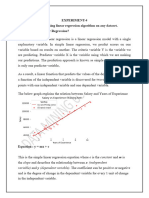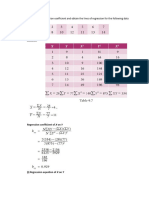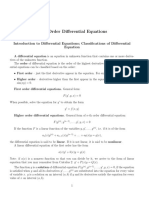Simple Linear Regression Code
Uploaded by
shalini gambhirSimple Linear Regression Code
Uploaded by
shalini gambhirDr.
Shalini Gambhir
AIML-Fundamentals of Machine Learning
Simple Linear Regression
Importing the libraries
import numpy as np
import matplotlib.pyplot as plt
import pandas as pd
Importing the dataset
dataset = pd.read_csv('Salary_Data.csv')
X = dataset.iloc[:, :-1].values
y = dataset.iloc[:, -1].values
Splitting the dataset into the Training set and Test set
from sklearn.model_selection import train_test_split
X_train, X_test, y_train, y_test = train_test_split(X, y, test_size = 1/3, random_state = 0)
Training the Simple Linear Regression model on the Training set
from sklearn.linear_model import LinearRegression
regressor = LinearRegression()
regressor.fit(X_train, y_train)
LinearRegression(copy_X=True, fit_intercept=True, n_jobs=None, normalize=False)
Predicting the Test set results
y_pred = regressor.predict(X_test)
Visualising the Training set results
plt.scatter(X_train, y_train, color = 'red')
plt.plot(X_train, regressor.predict(X_train), color = 'blue')
plt.title('Salary vs Experience (Training set)')
plt.xlabel('Years of Experience')
Dr. Shalini Gambhir
AIML-Fundamentals of Machine Learning
Dr. Shalini Gambhir
AIML-Fundamentals of Machine Learning
plt.ylabel('Salary')
plt.show()
Visualising the Test set results
plt.scatter(X_test, y_test, color = 'red')
plt.plot(X_train, regressor.predict(X_train), color = 'blue')
plt.title('Salary vs Experience (Test set)')
plt.xlabel('Years of Experience')
plt.ylabel('Salary')
plt.show()
Making a single prediction (for example the salary of an employee with 12 years of experience)
print(regressor.predict([[12]]))
[138967.5015615]
Therefore, our model predicts that the salary of an employee with 12 years of experience is $
138967,5.
Notice that the value of the feature (12 years) was input in a double pair of square brackets. That's
because the "predict" method always expects a 2D array as the format of its inputs. And putting 12
into a double pair of square brackets makes the input exactly a 2D array. Simply put:
12→scalar
[12]→1D array
[[12]]→2D array
Getting the final linear regression equation with the values of the coefficients
print(regressor.coef_)
print(regressor.intercept_)
[9345.94244312]
26816.192244031183
Therefore, the equation of our simple linear regression model is:
Salary=9345.94×YearsExperience+26816.19
Dr. Shalini Gambhir
AIML-Fundamentals of Machine Learning
Dr. Shalini Gambhir
AIML-Fundamentals of Machine Learning
To get these coefficients we called the "coef_" and "intercept_" attributes from our regressor object.
Attributes in Python are different than methods and usually return a simple value or an array of
values.
Dr. Shalini Gambhir
AIML-Fundamentals of Machine Learning
You might also like
- ES-341: Numerical Analysis: Dr. Mazhar Ali Mehboob Ul Haq (TA)No ratings yetES-341: Numerical Analysis: Dr. Mazhar Ali Mehboob Ul Haq (TA)32 pages
- Math10 - Q1 - Mod14 Illustrating Polynomial Equations Lessons-1-2 v3100% (3)Math10 - Q1 - Mod14 Illustrating Polynomial Equations Lessons-1-2 v331 pages
- 2.1 ML (Implementation of Simple Linear Regression in Python)No ratings yet2.1 ML (Implementation of Simple Linear Regression in Python)8 pages
- Simple Linear Regression in Machine LearningNo ratings yetSimple Linear Regression in Machine Learning7 pages
- Home Ai Machine Learning Dbms Java Blockchain Control System Selenium HTML Css Javascript DsNo ratings yetHome Ai Machine Learning Dbms Java Blockchain Control System Selenium HTML Css Javascript Ds11 pages
- ML Experiment No 1 Linear Regression AnalysisNo ratings yetML Experiment No 1 Linear Regression Analysis3 pages
- 2.3 ML (Implementation of Polynomial Regression Using Python)No ratings yet2.3 ML (Implementation of Polynomial Regression Using Python)9 pages
- Simple - Linear - Regression - Ipynb - ColaboratoryNo ratings yetSimple - Linear - Regression - Ipynb - Colaboratory2 pages
- Machine Learning Algorithm With Python ImplementationNo ratings yetMachine Learning Algorithm With Python Implementation34 pages
- Supervised Learning For Data Science...No ratings yetSupervised Learning For Data Science...14 pages
- C: Users Dell Downloads Salary - Data - CSVNo ratings yetC: Users Dell Downloads Salary - Data - CSV2 pages
- D.Y. Patil College of Engineering, Akurdi Department of Electronics & Telecommunication EngineeringNo ratings yetD.Y. Patil College of Engineering, Akurdi Department of Electronics & Telecommunication Engineering41 pages
- ANN-Unit 3 - Regression & Multi-Layer PerceptronNo ratings yetANN-Unit 3 - Regression & Multi-Layer Perceptron35 pages
- C1 W1 Lab03 Model Representation Soln-Copy1No ratings yetC1 W1 Lab03 Model Representation Soln-Copy17 pages
- Planar Trusses Solution Via Numerical MethodNo ratings yetPlanar Trusses Solution Via Numerical Method42 pages
- Numerical Methods and Programming Using MathematicaNo ratings yetNumerical Methods and Programming Using Mathematica14 pages
- Finite Element Methods For Maxwell's Equations: Davit HarutyunyanNo ratings yetFinite Element Methods For Maxwell's Equations: Davit Harutyunyan29 pages
- Chapter 2 Locating Roots of Equations T2 1415 PDFNo ratings yetChapter 2 Locating Roots of Equations T2 1415 PDF6 pages
- Numerical Analysis Sessional: Hafijur RahmanNo ratings yetNumerical Analysis Sessional: Hafijur Rahman16 pages
- Managerial Decision Modeling With Spreadsheets 3rd Edition Balakrishnan Solutions Manual Download100% (23)Managerial Decision Modeling With Spreadsheets 3rd Edition Balakrishnan Solutions Manual Download2 pages
- Strategies For Overcoming Uncertainties in Heat Exchanger Network SynthesisNo ratings yetStrategies For Overcoming Uncertainties in Heat Exchanger Network Synthesis20 pages
- Optimal Hedging of Options With Transaction Costs: Valeri I. ZakamoulineNo ratings yetOptimal Hedging of Options With Transaction Costs: Valeri I. Zakamouline13 pages
- Matrices and Determinants-Level - 3 - DTS-15-SolutionsNo ratings yetMatrices and Determinants-Level - 3 - DTS-15-Solutions3 pages
- Sequencing Problems Processing N Jobs Through M Machines Problem Example PDF100% (1)Sequencing Problems Processing N Jobs Through M Machines Problem Example PDF2 pages
- Topic 6: Numerical Integration: Do Ngoc DiepNo ratings yetTopic 6: Numerical Integration: Do Ngoc Diep37 pages
- B.Tech - AIDS 2nd Year Sem 1,2 Arrear SyllabusNo ratings yetB.Tech - AIDS 2nd Year Sem 1,2 Arrear Syllabus25 pages
- Applied Numerical Methods WMATLAB for Engineers and Scientists 3rd Edition Chapra Solutions Manual all chapter instant download100% (3)Applied Numerical Methods WMATLAB for Engineers and Scientists 3rd Edition Chapra Solutions Manual all chapter instant download38 pages

























































































